25 Common Types of Sparrows in Minnesota (With Pictures)
Last Updated on
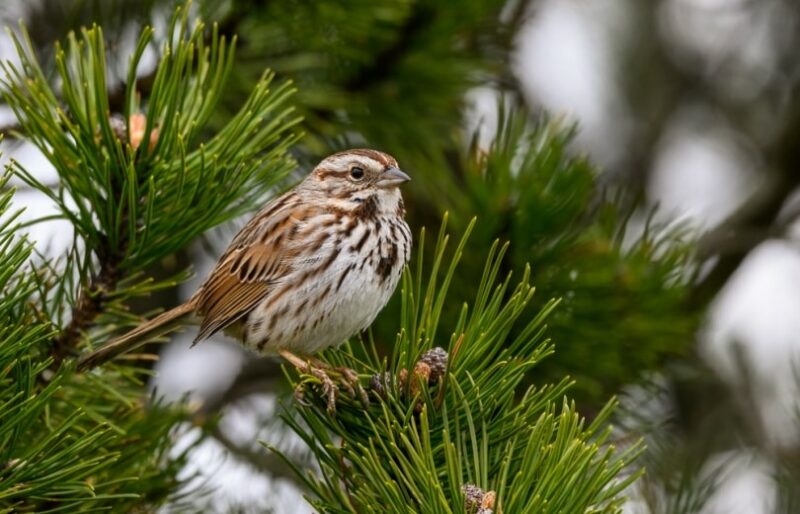
Sparrows are ubiquitous backyard birds in Minnesota, many sharing similar traits. They are part of the Passerellidae family, which consists of New World Sparrows or passerellids. That’s to distinguish them from species from Europe, Africa, and Asia, the so-called “Old World Sparrows.” Most are seed-eating birds, with some also taking insects and fruits.
Sparrows live in a diverse collection of habitats, from forests to parks to deserts. According to the International Ornithological Congress (IOC), there are 30 genera with 138 species in the Passerellidae family. It’s a broad classification that includes birds with names other than the sparrow. Nevertheless, they are part of this group.

The 25 Types of Sparrows in Minnesota
1. Grasshopper Sparrow (Ammodramus savannarum)

The Grasshopper Sparrow is a grassland bird, as its name implies. It lives throughout Minnesota, except for the northeastern corner. It has a brown-streaked back and pale chest. Its distinguishing characteristic is the yellow spots above its eyes. It is a ground-nesting bird with a raspy call that almost sounds like an insect. Its numbers have declined in recent years, making it a high priority for Partners in Flight (PIF).
2. LeConte’s Sparrow (Ammospiza leconteii)

The LeConte’s Sparrow is a common bird in the northern half of Minnesota during the breeding season. Its habitat includes wet meadows and marshes. It’s a challenging species to spot because of where it lives and its elusive nature. While scientists estimate the population is over 5 million, its numbers have declined, making it the highest priority for PIF because of habitat loss.
3. Nelson’s Sparrow (Ammospiza nelsoni)

The Nelson’s Sparrow is another wetland bird found mainly in north-central and northwest Minnesota. Interestingly, it also breeds in the northeastern coastal regions of Canada. Its numbers have increased in recent years, despite habitat loss. Nevertheless, the state has classified the bird as Minnesota Species of Special Concern. Despite the environmental pressure, it’s a common sight in its range.
4. Henslow’s Sparrow (Centronyx henslowii)

The Henslow’s Sparrow lives in shrubland and open fields. It’s primarily found in the southern half of the state, although it is a Minnesota endangered species. Human encroachment and habitat loss have taken a toll on its numbers. Its streaked plumage provides excellent camouflage. Its voice is also non-descript, making it another species that is often hard to find without binoculars or a spotting scope.
5. Lark Sparrow (Chondestes grammacus)
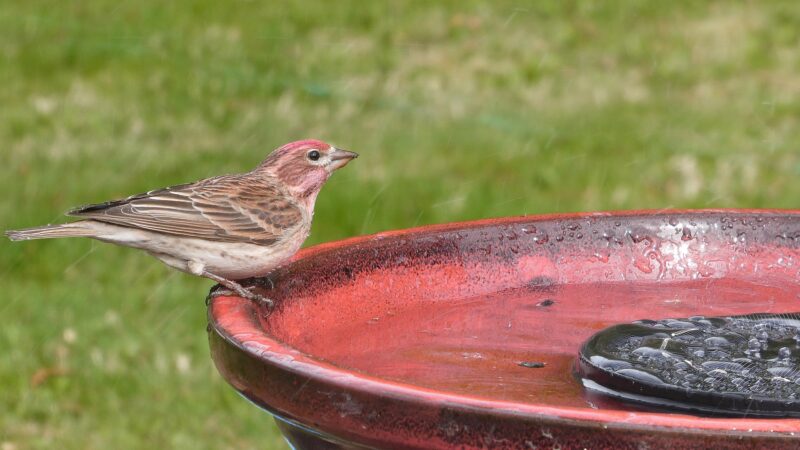
The Lark Sparrow is a handsome bird that is quick to spot in open fields and farmland, except in the northeastern part of the state. It is a ground feeder, spending much of its time foraging for seeds and insects. The bird has a melodious call that makes it easy to identify if you can’t see it. Its numbers have dropped in the last several years, making it a Minnesota Species of Special Concern.
6. Dark-eyed Junco (Junco hyemalis)
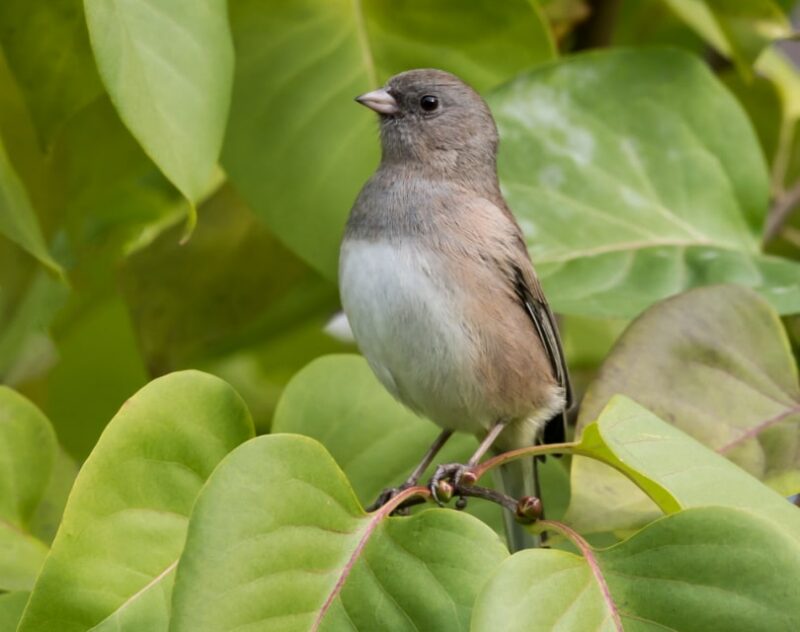
The Dark-eyed Junco is one of three birds on our list without “sparrow” in their name. While it’s a year-round resident up north, you’re more likely to see it during the winter in the southern half. It hops and scratches for seeds and insects. You may also notice it scavenging for leftovers under a bird feeder. The species is widespread throughout the United States and Canada.
7. Swamp Sparrow (Melospiza georgiana)
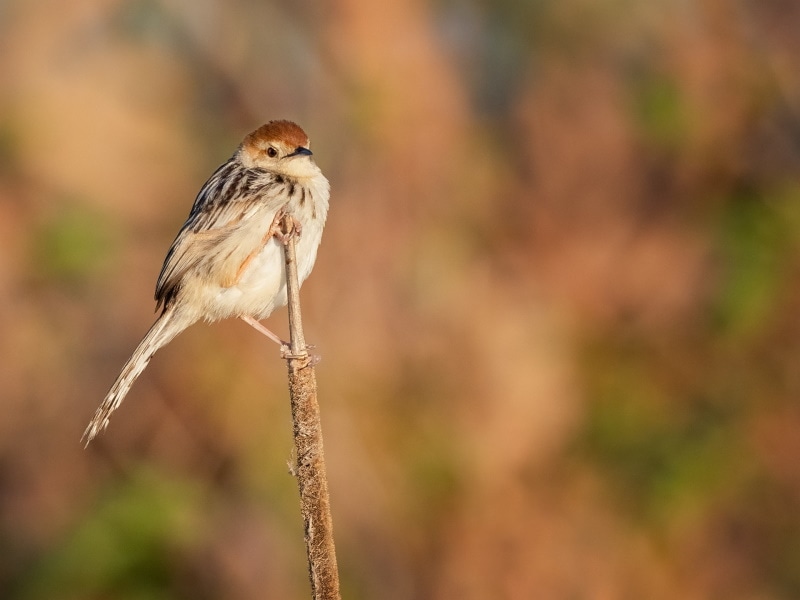
The Swamp Sparrow is a common sight in wetlands throughout the state. You may also see it in wet meadows or along wooded shorelines. It’s not as elusive as other species. You may even have luck drawing it closer to you with phishing. It’s another ground feeder that may wade into shallow water when foraging for insects. Its numbers have been increasing, despite concerns about habitat loss.
8. Lincoln’s Sparrow (Melospiza lincolnii)

The Lincoln’s Sparrow is widespread throughout the state and the continent. It prefers bogs, thickets, and dense grassy areas. It may be hard to see it, but you’ll know it’s around by its sweet song and sharp call notes. John James Audubon named the species after his friend Thomas Lincoln. He affectionately referred to the bird as Tom’s Finch.
9. Song Sparrow (Melospiza melodia)
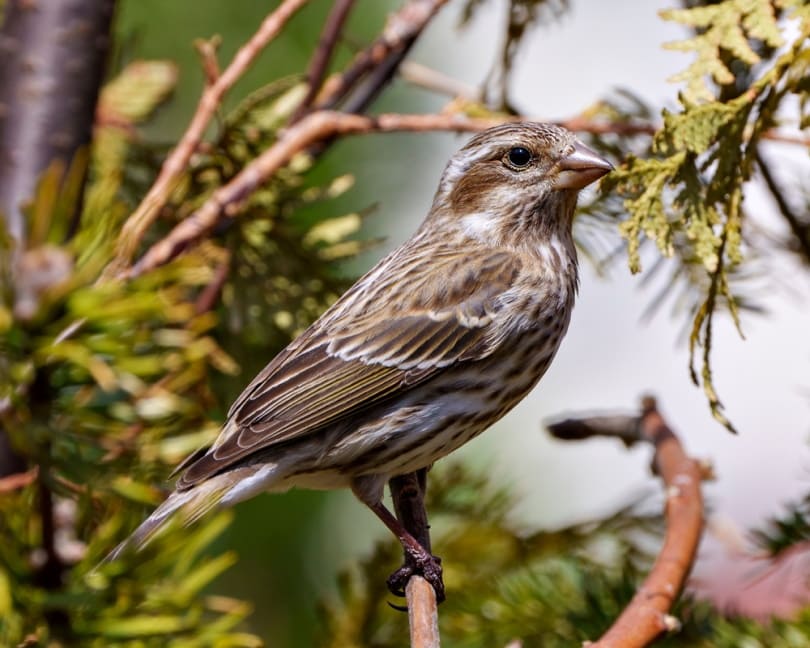
The name of the Song Sparrow is an excellent clue on how to identify this musical species. This group of birds is notoriously difficult to identify the individual species, except for this one. It has a red cap and a streaked body with a dark spot in the center of its chest. Its distinctive song is a repeated sweet, sweet sound. Its breeding ground includes the entire state of Minnesota.
10. Savannah Sparrow (Passerculus sandwichensis)
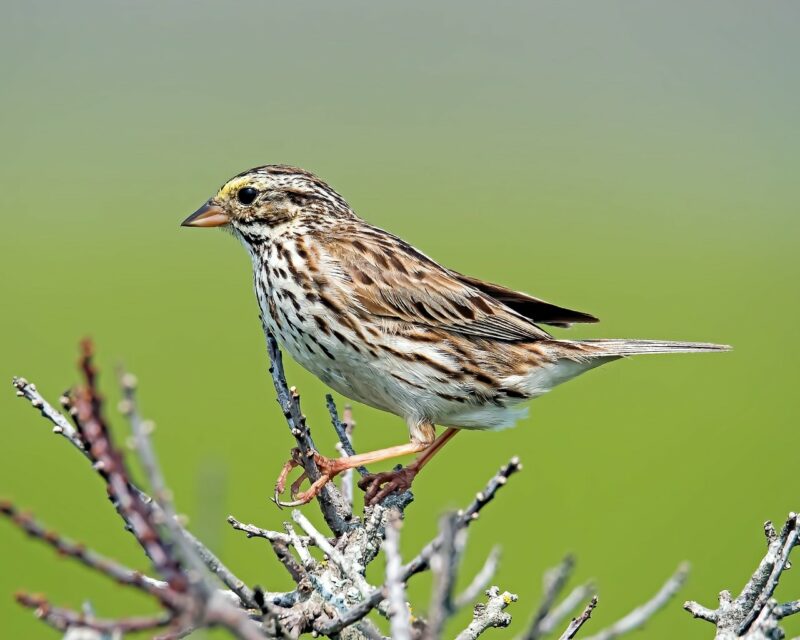
The Savannah Sparrow is a bird of the open country. It looks similar to our previous entry. Only this species has a yellow streak on its head. Its breeding range is the northern half of the country into Canada. While its streaked body can make it hard to spot, this bird isn’t shy around people like many others we’ve discussed. Its population is decreasing but has a large range throughout the continent.
11. Fox Sparrow (Passerella iliaca)
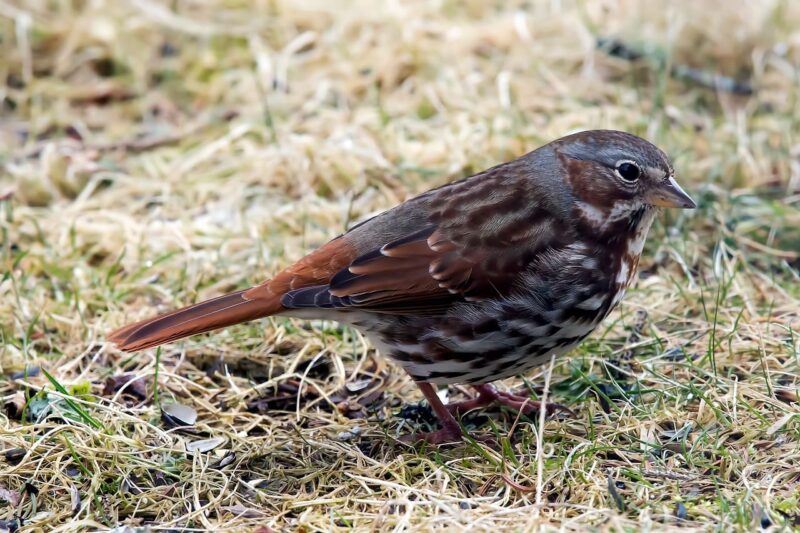
The Fox Sparrow is a large, rust-colored bird that occupies a range of habitats, including parks and gardens. While Minnesota isn’t part of its breeding range, it’s easy to identify going through the state during migration. Seeds and insects make up the majority of its diet. Like many sparrows, it is a ground feeder. It’s probably where you’ll most likely see it hopping around as it looks for food.
12. Eastern Towhee (Pipilo erythrophthalmus)
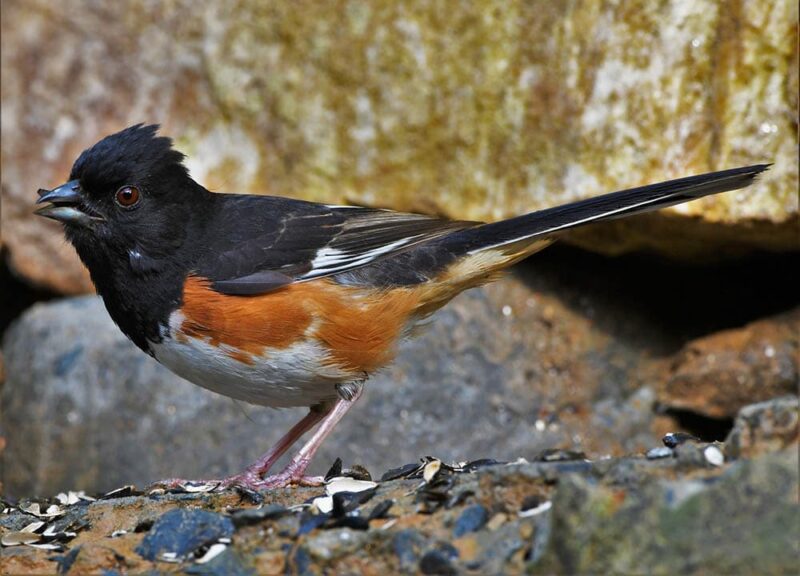
The Eastern Towhee is our second non-sparrow sparrow on our list. It’s slightly smaller than a robin with similar reddish plumage on its flanks. It forages on the ground and rarely goes much higher. It prefers open woods where it will hop around in the vegetation looking for food. You’re more likely to see this species in east-central Minnesota or during migration anywhere in the state.
13. Vesper Sparrow (Pooecetes gramineus)

The Vesper Sparrow lives in meadows and grasslands throughout Minnesota, except for the northeastern corner. It is another streaked species with noticeable pink feet and white outer tail feathers that make it easy to identify. Naturalist John Burroughs named the species. Its name means “of the evening,” when he thought the bird sang its best.
14. American Tree Sparrow (Spizelloides arborea)

The name of the American Tree Sparrow belies the fact that you’re more likely to see it in the open country than in forests. It’s a northern species that visits Minnesota as a winter migrant. It is a common sight throughout the state, except for the far northern reaches. It tends to avoid people, which may reflect what it encounters in less densely populated areas in its breeding range.
15. Clay-colored Sparrow (Spizella pallida)

The Clay-colored Sparrow is appropriately named since it describes most of its plumage. It prefers shrublands, especially if Jack Pines are present. Its breeding range includes the northern two-thirds of Minnesota. Like the Grasshopper Sparrow, its song is not bird-like at all but instead consists of short buzzing sounds.
16. Chipping Sparrow (Spizella passerina)

You’ll probably hear the Chipping Sparrow before you see it. Its call is distinctive and relatively loud for such a small bird. It has a red cap and a clear breast without any streaks. You’ll find it on farmlands, parks, and open woods. Its breeding range includes most of the country into Canada, with the entire state of Minnesota in the mix.
17. Field Sparrow (Spizella pusilla)
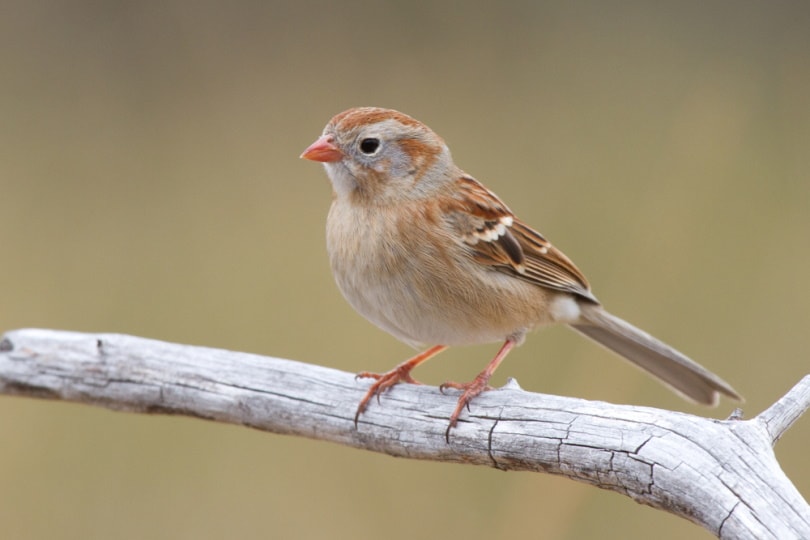
Unlike many species on our round-up, the Field Sparrow has probably benefited from forest clearing, given its name. It prefers areas with dense vegetation to provide cover. Its distinguishing traits are its pink bill and song, which sounds like a ping-pong ball dropping. Seeds compromise most of their diet. You can often see them grasping on flower stems, gobbling up what’s left.
18. White-throated Sparrow (Zonotrichia albicollis)
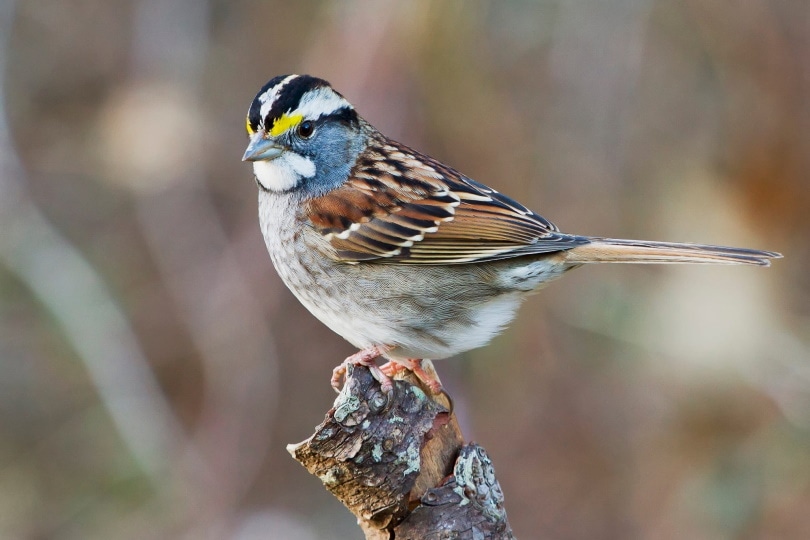
The White-throated Sparrow is widespread throughout Minnesota as a migrant in the southern half and part of its breeding range in the north. The bird has a unique song, which you’ll probably hear before spotting it. Some birdwatchers think it sounds like it’s saying, “Sweet Canada, Canada, Canada.” It’s perhaps not a stretch since it spends its summers through most of the country.
19. White-crowned Sparrow (Zonotrichia leucophrys)
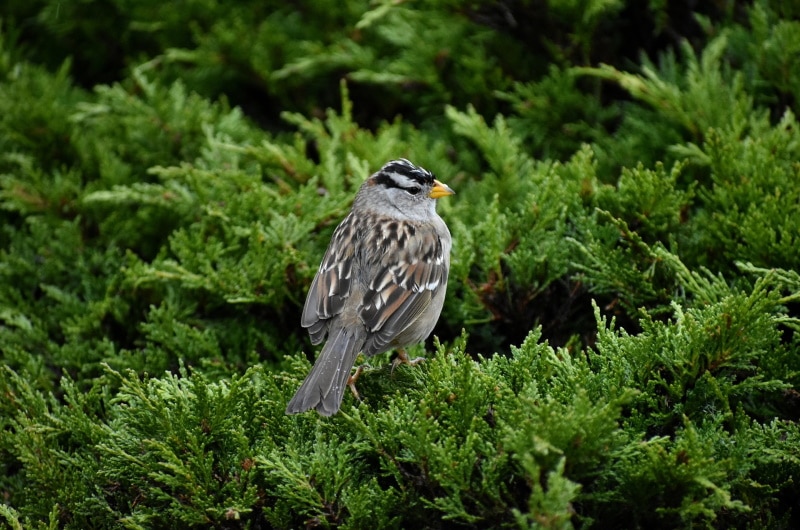
The White-crowned Sparrow lacks the white throat patch and yellow spots above the eyes of our last species. It’s also less common. It is a year-round resident in some parts of the state, although you’re more likely to see it as a migrant just passing through to someplace else. Like many birds, the song of this sparrow reflects local dialects.
20. Harris’s Sparrow (Zonotrichia querula)
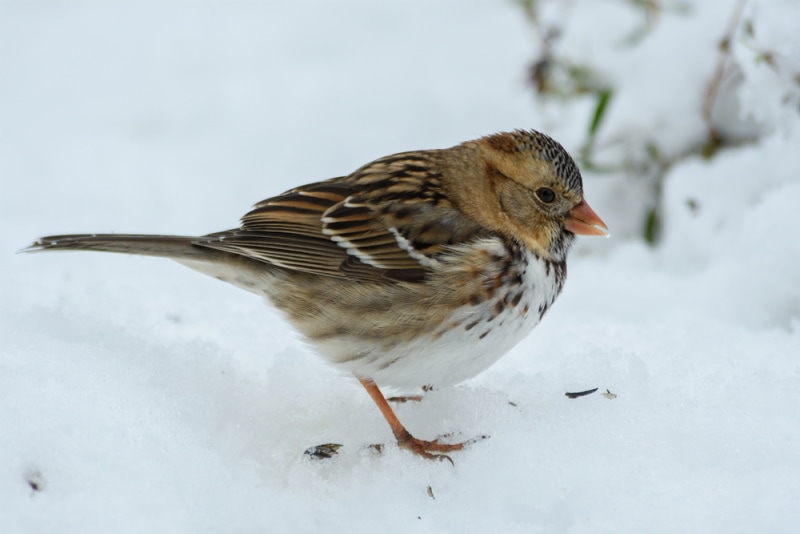
The Harris’s Sparrow is easy to identify with its black cap, face, and upper chest set against its pink bill. It avoids human disturbance, making it more difficult to find. It sometimes takes up residence in the western part of the state. Its preferred habitat is brushy thickets, often in spruce and other boreal trees. You may see it as a migrant passing through to its wintering grounds in the Southern Plains.
21. Black-throated Sparrow (Amphispiza bilineata)

The next few entries are uncommon or even rare in Minnesota. The Black-throated Sparrow is no exception. It’s probably an accidental species, with the last sighting reported in 2007 in the state. It prefers the deserts and shrublands of the American Southwest. Undoubtedly, habitat loss is affecting this species and its dwindling numbers. Its behavior and diet are similar to other sparrows.
22. Lark Bunting (Calamospiza melanocorys)

The Lark Bunting is hard to miss with its black body, save for white wing bars. It’s a bird of the prairie, which explains the drop in its numbers. Less than 2% of native prairie remains in Minnesota. Hence, the species is more common farther west, where more of this ecosystem exists. While it once was widespread in the state, the last sighting was in 2018.
23. Baird’s Sparrow (Centronyx bairdii)

The Baird’s Sparrow is a state-endangered species. It is another victim of the loss of prairies to agriculture and development. The last reported sighting was in 2016. It prefers the tallgrass prairies that exist in the eastern part of the United States. Even in places where it’s widespread, it’s hard to find since it’s a ground feeder amongst this tall vegetation.
24. Brewer’s Sparrow (Spizella breweri)

The Brewer’s Sparrow is another bird of the prairies but farther west than Minnesota. It is widespread in these areas. The last sighting in the state was in 2015. It’s a hardy species that sometimes ventures above the treeline in the Rockies. Its plumage is non-descript, probably making it difficult to spot. You’re more likely to identify it by its melodious song.
25. House Sparrow (Passer domesticus)

We included the House Sparrow on our list even though it’s not part of the Passerellidae family but the Passeridae instead. It has Old World species like this one. It was introduced into the United States and is widespread throughout the United States, Canada, and Mexico. It eats seeds primarily, although it will take the occasional insect. You can think of it as the raccoon of the bird world since it tolerates us.

Final Thoughts
Sparrows are a diverse group of birds, occupying a broad range of habitats. We’ve also seen varying degrees of tolerance of humans, going from the aloof LeConte’s Sparrow to the almost friendly House Sparrow. These species play a vital role in the ecosystem by controlling insect populations and acting as seed dispersers. They offer an excellent way to test your birdwatching skills.
Featured Image Credit: FotoRequest, Shutterstock
Table of Contents
- The 25 Types of Sparrows in Minnesota
- 1. Grasshopper Sparrow (Ammodramus savannarum)
- 2. LeConte’s Sparrow (Ammospiza leconteii)
- 3. Nelson’s Sparrow (Ammospiza nelsoni)
- 4. Henslow’s Sparrow (Centronyx henslowii)
- 5. Lark Sparrow (Chondestes grammacus)
- 6. Dark-eyed Junco (Junco hyemalis)
- 7. Swamp Sparrow (Melospiza georgiana)
- 8. Lincoln’s Sparrow (Melospiza lincolnii)
- 9. Song Sparrow (Melospiza melodia)
- 10. Savannah Sparrow (Passerculus sandwichensis)
- 11. Fox Sparrow (Passerella iliaca)
- 12. Eastern Towhee (Pipilo erythrophthalmus)
- 13. Vesper Sparrow (Pooecetes gramineus)
- 14. American Tree Sparrow (Spizelloides arborea)
- 15. Clay-colored Sparrow (Spizella pallida)
- 16. Chipping Sparrow (Spizella passerina)
- 17. Field Sparrow (Spizella pusilla)
- 18. White-throated Sparrow (Zonotrichia albicollis)
- 19. White-crowned Sparrow (Zonotrichia leucophrys)
- 20. Harris’s Sparrow (Zonotrichia querula)
- 21. Black-throated Sparrow (Amphispiza bilineata)
- 22. Lark Bunting (Calamospiza melanocorys)
- 23. Baird’s Sparrow (Centronyx bairdii)
- 24. Brewer’s Sparrow (Spizella breweri)
- 25. House Sparrow (Passer domesticus)
- Final Thoughts
About the Author Chris Dinesen Rogers
Chris has been writing since 2009 on a variety of topics. Her motto with all of her writing is “science-based writing nurtured by education and critical thinking.” Chris specializes in science topics and has a special love for health and environmental topics, and animals of all shapes and sizes.
Related Articles:
Monocular vs Telescope: Differences Explained (With Pictures)
10 Types of Hummingbirds in Arkansas (With Pictures)
8 Types of Hummingbirds in Nebraska (With Pictures)
5 Types of Hummingbirds in Idaho (With Pictures)
3 Types of Hummingbirds in Mississippi (With Pictures)
8 Types of Hummingbirds in Kansas (With Pictures)
5 Types of Hummingbirds in West Virginia (With Pictures)
5 Types of Hummingbirds in Ohio (With Pictures)
